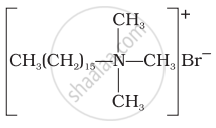Advertisements
Advertisements
प्रश्न
If water contains dissolved calcium hydrogen carbonate, out of soaps and synthetic detergents which one will you use for cleaning clothes?
उत्तर १
Synthetic detergents are preferred for cleaning clothes. When soaps are dissolved in water containing calcium ions, these ions form insoluble salts that are of no further use.
However, when synthetic detergents are dissolved in water containing calcium ions, these ions form soluble salts that act as cleansing agents.
उत्तर २
Calcium hydrogencarbonate makes water hard. Therefore, soap cannot be used because it gets precipitated in hard water. On the other hand, a synthetic detergent does not precipitate in hard water because its calcium salt is also soluble in water. Therefore, synthetic detergents can be used for cleaning clothes in hard water.
APPEARS IN
संबंधित प्रश्न
Explain the following term with a suitable example:
Cationic detergents
Explain the following terms with suitable examples - Non-ionic detergents
What are biodegradable and non-biodegradable detergents? Give one example of each.
Label the hydrophilic and hydrophobic parts in the following compounds.
CH3(CH2)10CH2OSO3 –Na+
What are anionic detergents? Give an example ?
Define the following term with a suitable example:
Cationic detergents
Which of the following are anionic detergents?
(i) Sodium salts of sulphonated long-chain alcohol.
(ii) Ester of stearic acid and polyethylene glycol.
(iii) Quarternary ammonium salt of amine with acetate ion.
(iv) Sodium salts of sulphonated long-chain hydrocarbons.
Which category of the synthetic detergents is used in toothpaste?
Hair shampoos belong to which class of synthetic detergent?
Draw the diagram showing micelle formation by the following detergent.
\[\ce{CH3(CH2)10CH2OS\overset{-}{O}3\overset{+}{N}a}\]
How does the branching of hydrocarbon chain of synthetic detergents affect their biodegradability?
Match structures given in Column I with the type of detergents given in Column II.
| Column I | Column II |
| (i) \[\ce{CH3(CH2)16COO(CH2CH2O) nCH2CH2OH}\] | (a) Cationic detergent |
| (ii) \[\ce{C17H35COO- Na+}\] | (b) Anionic detergent |
| (iii) \[\ce{CH3-(CH2)10CH2SO3- Na+}\] | (c) Nonionic detergent |
|
(iv) |
(d) Soap |
Synthetic detergents have advantage over usual soaps as far as cleansing power is concerned. But use of synthetic detergents over a long time creates environmental pollution. How can the pollution caused by synthetic detergents be minimised? Classify the detergents according to their chemical nature.
Explain the following term with suitable examples.
cationic detergents
Explain the following term with suitable examples.
Cationic detergents
Explain the following term with suitable example cationic detergents.
Explain the following term with a suitable example:
Cationic detergents
Explain the following term with suitable example:
cationic detergents

